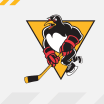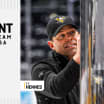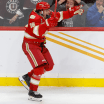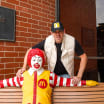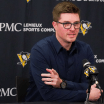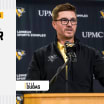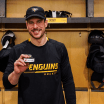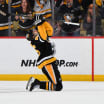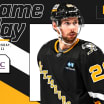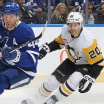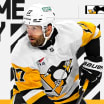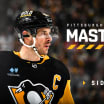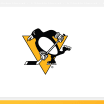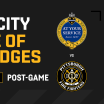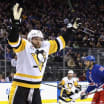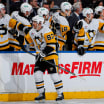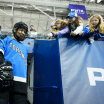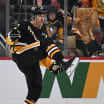Injuries are a part of hockey. As Penguins head coach Mike Sullivan likes to say, the sport is one that's 'belligerent in nature.'
With the Penguins having 302 man-games lost this season due to injury and some offseason surgeries, PittsburghPenguins.com spoke with Medical Director and Head Team Physician Dr. Dharmesh Vyas, M.D. Ph.D. and Head Athletic Trainer Chris Stewart for insight into how they treat injured players in a myriad of different situations.
"From the minute they step in a building to the second they leave, we're making sure that they're safe, health-wise, and we're prepared to intervene with any kind of first aid, medical attention, rehab, anything like that," Stewart said. "We need to make sure that their health and safety is the first priority."
A Look at How the Penguins Treat Injured Players
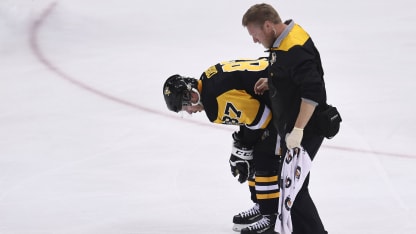
\\\
On a home game day, both Vyas and Stewart get to PPG Paints Arena about two hours before puck drop.
As soon as they both arrive, Vyas will review the full list of injuries with Stewart. That list consists of players who are out of the lineup, players who are battling through bumps and bruises, and players potentially returning back to the lineup that night.
From there, Stewart does pre-game treatments with the players while Vyas goes over his pre-game checklist of medical supplies and emergency protocols.
That process includes checking on the X-ray machine to make sure it is up and running; checking with the athletic trainers that the automated external defibrillator and tourniquets are set; making sure that the iPad that runs concussion tests is logged on and connected to WiFi, meeting in person with the emergency medical technicians (EMT) on stand-by with an ambulance, and organizing his laceration repair equipment, which consists of local anesthetic, syringes, instruments and suture, saline, and dressings.
About an hour before puck drop, the UPMC consultants will arrive.
In addition to assistant team physician Dr. Melissa McLane, D.O., Vyas has an orthopedic sports medicine fellow-in-training with him.
The team also includes a dentist, an ophthalmologist, a neurosurgeon and a doctor that specializes in head and neck injuries. That includes facial injuries, like the broken facial bones that John Marino sustained after getting hit with a slapshot from Steven Stamkos last season.
Rounding out the group is an ER doctor, whose presence became mandatory across the league after former Dallas Stars forward Rich Peverley went into cardiac arrest on the bench in 2014.
"We provide more service than many teams in the league in terms of the amount of medical staff," Vyas said. "That's not typical for most teams. At UPMC, we have several great physicians in practically every medical subspeciality. We take advantage of this luxury by inviting teams of consultants to help us provide the best possible care of our team."
Once the consultants arrive, Vyas checks with them to make sure their supplies are organized and that everyone's communication devices work. Vyas and Stewart use walkie-talkies, while the consultants use pagers.
As the game is about to begin, Stewart takes his place standing at the far end of the bench while Vyas sits down in Suite 66, which is right next to the bench on the opposite side of the runway.
Once the puck drops, the head athletic trainer and the head team physician approach the game from two different perspectives.
For Stewart, who is right in the midst of all the chaos, his focus tends to be on the play. If something does happen to a player, assistant athletic trainer Patrick Steidle will take over following the action.
"You do get to enjoy the game, but you're really just focusing on the fact that at any second, you might have to do something," Stewart said.
For Vyas, his focus tends to be away from the play so that he has eyes on what the cameras don't catch.
"Oftentimes I can see a replay if I need to," Vyas said. "But it's the play that's out of frame that I'm watching many times when hits take place. Some injuries can happen there without even being recognized."
He always watches from the perspective of a doctor more than as a fan. Because of that, whenever Vyas gets home after a game, he tends to catch a few minutes of the Western Conference games before he goes to bed.
"It's very difficult to go right to bed because of the after-effects of the adrenaline rush that comes with each game," Vyas said. :This is due to the excitement of the competition, the bright lights, and loud sounds of crowd noise and music. So I'll have a game on in the background just to watch it and decompress before going to bed."
If an injury does occur - say a blocked shot - and the player can skate back to the bench on his own accord, Stewart will evaluate from there after the player tells him what happened.
"You make a decision whether to take them off the ice to have it further evaluated, or just let them play through it and get them evaluated after the game or between periods," he said.
But if the injury does happen to require heading to the locker room right away, Vyas will leave his seat in Suite 66, head down the runway and meet Stewart and the player there.
"The first thing I do is just let the player gather himself," Vyas said. "Probably the biggest mistake is to try and ask too many questions right away. The player is trying to figure out in their own mind what just happened, and they're frustrated and in pain. So I let them talk once they're ready. They need to come down from the shock of the injury and let their fight-or-flight response settle down before they are ready to tell me what's going on."
Stewart agreed that giving them as much time as they can within the circumstances is key. And while one might assume that it could be difficult to block out the intensity and chaos that comes with a hockey game and try to rush back, Penguins winger Bryan Rust said that isn't necessarily the case.
"I think it's relatively easy (to block it all out) if you're in enough discomfort," Rust said. "You'll go back to the locker room right away and it's quiet back there. There isn't too much going on. So you'll take a few minutes to calm down, and then you really know how bad it actually feels, and then just go from there."
Sometimes, the player will tell Vyas he's just going to walk it off and that he'll be okay. In that case, Vyas will tell the player to let Stewart know if it gets any worse and they'll re-evaluate.
But if the player can't walk it off, most of the time Vyas knows what happened because he saw it live. But he still asks the player to describe what happened and where it hurts in his own words, and have them remove their gear at the site of the injury to take a better look.
From there, Vyas will go and review the footage of the play if it's available with the video coaches, using Hawk-Eye's Synchronized Multi-Angle Replay Technology (SMART) System to get an in-depth look and take his time to make a proper evaluation.
"I can go back and forth in slo-mo and frame by frame, and depending on what I see, we would decide if he needs X-rays or not," Vyas said.
If he determines that X-rays are not necessary, Vyas and Stewart will let the injury settle before having the player test it during a TV timeout.
"I let him skate and I watch him," Vyas said. "We talk, and he tells me if it's a go or no go. Then we'll review again at intermission or at the end of the game, depending on how he did. We don't do pain meds because we're not trying to artificially mask a problem. We'll do an anti-inflammatory, but that's about the upper limit of medications for pain."
If he determines that X-rays ARE necessary, Vyas will take them, read them and make a decision as to whether or not the player can return.
"If (Vyas) is confident and comfortable, it comes down to the player functionally being able to play," Stewart said. "If Dr. Vyas isn't comfortable with the X-rays, if there's any doubt, then we hold the player out and do further imaging the next day."
That's exactly what happened when Rust injured his hand blocking a shot in a preseason game against Buffalo last September.
"I went straight down to the locker room and they immediately took X-rays," Rust said. "They didn't find anything on the X-rays, but obviously I wasn't going back in the game since I didn't feel good enough to go back in, especially in a preseason game. So they said okay, that's good there's nothing on the X-rays, it would still be a good precautionary measure to go and get further testing; get an MRI and a CT scan if need be. So I think I ended up getting both of those the next day, and that revealed a fracture in my wrist."
If the injury is more serious to where the player can't make his way back to the bench, Stewart is the first one on the ice to attend to him.
"It's a case-by-case basis where you determine first breathing, then are they aware, alert, conscious, all that stuff," Stewart said. "As long as that's okay, then you make a determination after that on how you proceed on getting the player off the ice."
If it's an injury like the broken left fibula that Justin Schultz suffered in Montreal on Oct. 13, 2018, Vyas will join Stewart on the ice in figuring out how to best to get the player off the ice - whether the player can skate off with assistance, needs the extremity immobilized, or a stretcher is required.
If it's a very serious injury, Stewart will raise his arm above his head, which initiates the emergency protocol. That means Emergency Medical Services (EMS), the ER doctor and Vyas would all come onto the ice to determine the next steps, like whether or not they need to stabilize the spine.
If it's an injury that will require surgery, Vyas typically organizes the entire process.
If that situation happens at home, like Jake Guentzel injuring his shoulder at PPG Paints Arena on Dec. 30, 2019, Vyas coordinated surgery that same night. As soon as the game was over, Vyas took Guentzel to the operating room at UPMC Presbyterian Hospital and teamed up with Dr. Ivan Tarkin of UPMC Orthopaedic Trauma Surgery to perform the surgery in the early hours of the morning.
If that situation happens on the road, like Brian Dumoulin injuring his ankle at Enterprise Center in St. Louis earlier that month during the second game of a back-to-back, Vyas will immediately get on the phone.
"For the whole medical staff, coordinated teamwork is of the upmost importance" Vyas said. "I have to delegate to my assistant physician/consultants; I have to delegate to the athletic trainers. It's a lot of coordination, one can't do it all by oneself. It literally takes a host of medical staff in order to get it all done in a timely and efficient manner."
In Dumoulin's case, Vyas had to coordinate the surgery as the team left the arena, boarded a bus to the airport and then got on a plane. With the one-hour time change, they arrived back in Pittsburgh later than usual. After landing, they went to UPMC Presbyterian Hospital, where Vyas again performed the surgery in the early hours of the morning with Dr. MaCalus Hogan and Dr. John Fowler of UPMC.
The Penguins announced at 11:45 a.m. that Dumoulin's surgery was successful, and shortly after that, Vyas made it to the team's annual holiday party at PPG Paints Arena essentially running on fumes.
"As surgeons, you get used to performing on low sleep," Vyas said. "It's a lifestyle adjustment, training for which starts in medical school. Some of it is predicated on adrenaline but most of it is knowing that you will be tired and understanding your body, so that you know when you're too tired to go on."
If McLane is traveling with the team, Vyas will be in constant communication with Stewart throughout the course of the game. Stewart will be in touch with him between periods, or if something serious happens during play, he will step away from the bench to call Vyas.
"I probably communicate with the athletic trainer about four or five times per game that's on the road," Vyas said. "At the beginning of the game, at the end of every game, and multiple times throughout the game depending on the game itself. And then if somebody were to get injured, then I have to coordinate when they're coming back, how they get back, where I'm going to meet them and what imaging needs to be done."
That relationship between the head athletic trainer and head team physician is of the utmost importance, especially since Stewart is around the team on a daily basis and has eyes on the players from the moment they step into the building on any given day until the second they leave.*
Stewart is the direct line of communication to Vyas, who is there for home games and most road games, as the Penguins are just one of two NHL teams - along with Chicago - who routinely travel with team physicians for every away game in the regular season.
"(The training staff) is making decisions on a daily basis where we say, is it safe for this player to keep practicing, or what do I feel needs to be done," Stewart said. "But if I have any doubt, I just pick up the phone and give Dr. V a call. We discuss and then we come up with a plan."
From there, Stewart and Vyas are the direct line of communication to the coaching staff and management from the players. And for them, their relationships with those players are just as critical.
They both said that when it comes to the players' care, the most important thing is to develop an understanding with each individual and know how they respond to an injury.
"Some people try to minimize it, others maximize it," Vyas said. "Some will try to ignore it for a while, others will tell you right away. But the biggest skill for me, and one that I really developed when we travel with our players because I get to get to spend more time with them, is just knowing my individual players' personalities and understanding when something is not right."
Meanwhile, Stewart has been with the Penguins since 2006, so not only does he have a trust level with the leadership group who have also been around since that time - he has a wealth of experience to draw on from dealing with so many different personalities over the years.
"You work with them, you gain trust, and then they trust you enough where they're allowing you to make decisions for them with their input," Stewart said.
"Knowing how each player reacts to certain things is very important because you can't overlook anything. Especially something simple where they don't think it's a big deal, because these guys do go through a lot of stuff - pain and bruising and injuries - where sometimes you have to step in and make the correct decision and protect the athlete."
Rust praised the job that the medical staff does when it comes to their health and safety.
"I have a great comfort level with them," Rust said. "Certain guys are different. Some guys, when they get hurt, they want to jump right back into the gym and be in there the next day doing whatever they can. If they have an upper-body injury, they still want to be doing legs and vice versa and things like that. But there's also guys who might want to take a couple days off and regroup and calm down a little bit from either being upset or have the injury bug them.
"So I think they do a really good job of trying to communicate with the player in order to find the best schedule early on. Going from there, it's pretty much a daily conversation, talking 3-4 times a day about how you're feeling. If things are feeling good, then there starts to be more of a progression. If that feels good, then it continues on. But obviously they have a certain timeline until anything can start. Once it starts, they do a really good job of moderating the progression and getting feedback from the player about what works, what doesn't work, what's still bothering you and what's feeling good. Their communication has been really good and is vital in making sure everything goes smooth."

